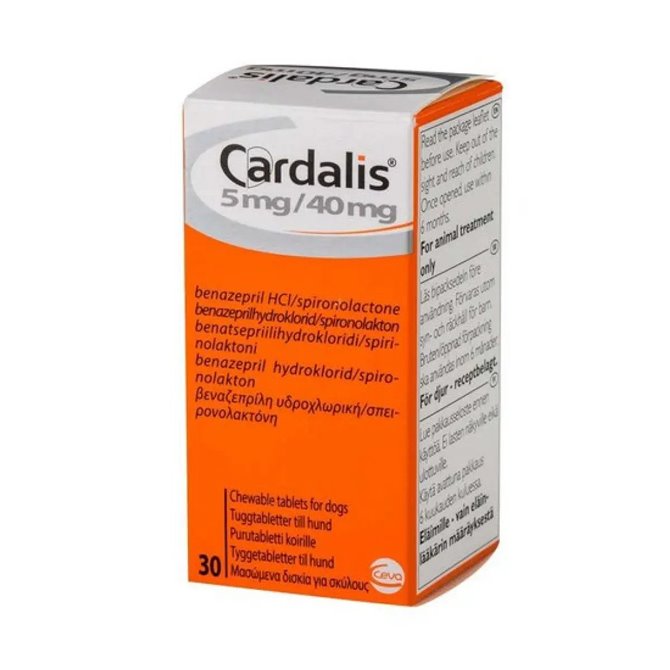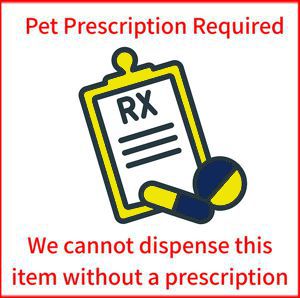
5mg/40mg Cardalis Tablet for Dogs - per tablet
721955
5mg/40mg Cardalis for Dogs is a new treatment for congestive heart failure and combines the diuretic Spironolactone with the ACE inhibitor Benazeapril. VET PRESCRIPTION REQUIRED.
Product Features
- Pack Size: - Sold Individually
- Target Animal: - Dog (Canine)
- Pet Prescription Required?: - Yes (For UK Orders)
- Active Ingredient: - Benazepril and Spironolactone
- Product Name: - 5mg/40mg Cardalis Tablet for Dogs - per tablet
More Information
Description
Cardalis Tablets may only be supplied with a valid veterinary prescription issued by your vet. You should only purchase Cardalis tablets if you have or are in the process of arranging such a prescription. See information bar for further details.
For the treatment of congestive heart failure caused by chronic degenerative valvular disease in dogs (with diuretic support as appropriate).
Dosage and administration
Oral use. This fixed combination product should only be used in dogs which require both active substances to be administered concomitantly at this fixed dose.
Cardalis tablets should be administered to the dog once a day using a dosage of 0.25 mg/kg bodyweight (bw) benazepril hydrochloride (HCl) and 2 mg/kg bodyweight spironolactone.
The tablets should be administered with food, either mixed with a small amount of food offered to the dog just prior to the main meal, or with the meal itself.
Dosages are as follow:
2.5 - 5kg : 1/2 tablet Cardalis 2.5 mg/20 mg
5 - 10 kg: 1 tablet Cardalis 2.5 mg/20 mg
10 - 20kg : 1 tablet Cardalis 5 mg/40 mg
20 - 40kg : 1 tablet Cardalis 10 mg/80 mg
40 - 60kg : 1 + 1/2 tablet Cardalis 10 mg/80 mg
60 - 80kg : 2 tablets Cardalis 10 mg/80 mg
Contraindications, warnings etc
Do not use during pregnancy and lactation; embryotoxic effects (foetal urinary tract malformation) were seen in trials of benazepril with laboratory animals (rats) at maternally non-toxic doses.
Do not use in dogs intended or used for breeding.
Do not use in dogs suffering from hypoadrenocorticism, hyperkalaemia or hyponatraemia.
Do not administer in conjunction with Non Steroidal Anti-Inflammatory Drugs (NSAIDs) to dogs with renal insufficiency.
Do not use in case of hypersensitivity to Angiotensin-Converting Enzyme inhibitors (ACE inhibitors) or to any of the excipients.
Do not use in cases of cardiac output failure due to aortic or pulmonary stenosis.
Special precautions for use in animals
Kidney function and serum potassium levels should be evaluated before initiating the treatment with benazepril and spironolactone, especially in dogs which may suffer hypoadrenocorticism, hyperkalaemia or hyponatraemia. Unlike in humans, an increased incidence of hyperkalaemia was not observed in clinical trials performed in dogs with this combination. However, regular monitoring of renal function and serum potassium levels is recommended in dogs with renal impairment, as they may have an increased risk of hyperkalaemia during treatment with this product.
Due to the antiandrogenic effect of spironolactone, it is not recommended to administer the veterinary medicinal product to growing dogs.
To be used with caution to treat dogs with hepatic dysfunction because it may alter the extensive biotransformation of spironolactone in liver.
Adverse reactions
A reversible prostatic atrophy is often observed in entire male dogs treated with spironolactone.
Interaction with other medicinal products and other forms of interaction
Furosemide has been used together with this combination of benazepril hydrochloride and spironolactone in dogs with heart failure without any clinical evidence of adverse interactions.
The concomitant administration of this veterinary medicinal product with other anti-hypertensive agents (e.g. calcium channel blockers, β-blockers or diuretics), anaesthetics or sedatives may potentially lead to additive hypotensive effects.
The concomitant administration of this veterinary medicinal product with other potassium-sparing treatments (such as ß-blockers, calcium channels blockers, angiotensin receptor blockers) may potentially lead to hyperkalaemia.
The concomitant use of NSAIDs with this veterinary medicinal product may reduce its anti-hypertensive effect, its natriuretic effect and increase the level of serum potassium. Therefore, dogs treated concomitantly with an NSAID should be closely monitored and correctly hydrated.
The administration of deoxycorticosterone with the product may lead to a moderate reduction of the natriuretic effects (reduction of urinary sodium excretion) of spironolactone.
Spironolactone decreases digoxin elimination and hence raises digoxin plasma concentration. As the therapeutic index for digoxin is very narrow, it is advisable to monitor closely dogs receiving both digoxin and a combination of benazepril hydrochloride and spironolactone.
Spironolactone may cause both induction and inhibition of cytochrome P450 enzymes and could affect the metabolism of other substances utilizing these metabolic pathways. Therefore, the product should be used with caution with other veterinary medicinal products which induce, inhibit, or which are metabolised by these enzymes.
Overdose
After administration of up to 10 times the recommended dose (2.5 mg/kg bw benazepril hydrochloride, 20 mg/kg bw spironolactone) to healthy dogs, dose dependant adverse effects were noted.
Daily overdoses to healthy dogs, that is, 6 times (1.5 mg/kg bw benazepril hydrochloride and 12 mg/kg bw spironolactone) and 10 times (2.5 mg/kg bw benazepril hydrochloride and 20 mg/kg bw spironolactone) the recommended dose, led to a slight dose related decrease in red cell mass. However, this very slight decrease was transient, the red cell mass remained within the normal range, and the finding was not considered to be of clinical importance. A dose related but moderate compensatory physiological hypertrophy of the zona glomerulosa of the adrenal glands was also observed at doses of 3 times and greater of the recommended dose. This hypertrophy does not seem to be linked to any pathology and was observed to be reversible upon discontinuation of the treatment.
In case of the accidental ingestion by a dog of many Cardalis tablets, there is no specific antidote or treatment. It is therefore recommended to induce vomiting, and then carry out gastric lavage (depending on the risk assessment) and monitor electrolytes. Symptomatic treatment, e.g., fluid therapy, should also be provided.
Special precautions to be taken by the person administering the veterinary medicinal product to animals
Wash hands after use.
People with known hypersensitivity to benazepril or spironolactone should avoid contact with the veterinary medicinal product.
Pregnant women should take special care to avoid accidental oral exposure because ACE inhibitors have been found to affect the unborn child during pregnancy in humans.
In case of accidental ingestion, seek medical advice immediately and show the package leaflet or the label to the physician.
For animal use only. Keep out of reach and sight of children. Any unused veterinary medicinal product or waste materials derived from such veterinary medicinal products should be disposed of in accordance with local requirements.
This veterinary medicinal product does not require any special storage conditions. Shelf-life after first opening: 6 months.
Legal Category
POM-V
Pharmacotherapeutic group: ACE inhibitors, combinations
ATCvet code: QC09BA07
Pharmacodynamic properties
Spironolactone and its active metabolites (including 7-α-thiomethyl-spironolactone and canrenone) act as specific antagonists of aldosterone by binding competitively to mineralocorticoid receptors located in the kidneys, heart and blood vessels. In the kidney, spironolactone inhibits the aldosterone-induced sodium retention leading to increase in sodium, and subsequently water excretion, and potassium retention. The resulting reduction in extracellular volume decreases the cardiac preload and left atrial pressure. The result is an improvement in heart function. In the cardiovascular system, spironolactone prevents the detrimental effects of aldosterone. Aldosterone promotes myocardial fibrosis, myocardial and vascular remodelling and endothelial dysfunction, although the precise mechanism of action is not yet clearly defined. In experimental models in dogs, it was shown that long term therapy with an aldosterone antagonist prevents progressive left ventricle dysfunction and attenuates left ventricle remodelling in dogs with chronic heart failure.
Benazepril hydrochloride is a prodrug hydrolysed in vivo into its active metabolite, benazeprilat. Benazeprilat is a highly potent and selective inhibitor of angiotensin converting enzyme (ACE), thus preventing the conversion of inactive angiotensin I to active angiotensin II. Therefore, it blocks effects mediated by angiotensin II, including vasoconstriction of both arteries and veins, retention of sodium and water by the kidney.
The product causes a long-lasting inhibition of plasma ACE activity in dogs, with more than 95% inhibition at peak effect and significant activity (>80%) persisting 24 hours after dosing.
The association of spironolactone and benazepril is beneficial as both act on the renin-angiotensin-aldosterone system (RAAS) but at different levels along the cascade.
Benazepril, by preventing the formation of Angiotensin-II, inhibits the detrimental effects of vasoconstriction and stimulation of aldosterone release. However, aldosterone release is not fully controlled by ACE Inhibitors because Angiotensin-II is also produced by non-ACE pathways such as chymase (phenomenon known as “aldosterone breakthrough”). Secretion of aldosterone can also be stimulated by factors other than Angiotensin-II, notably K+ increase or ACTH. Therefore, to achieve a more complete inhibition of the deleterious effects of RAAS overactivity which occurs with heart failure, it is recommended to use aldosterone antagonists, such as spironolactone, concomitantly with ACE inhibitors to block specifically the activity of aldosterone (regardless of the source), through competitive antagonism on mineralocorticoid receptors. Clinical studies investigating the survival time demonstrated that the fixed combination increased the life expectancy in dogs with congestive heart failure with a 89% reduction in the relative risk of cardiac mortality assessed in dogs treated with spironolactone in combination with benazepril (as hydrochloride) compared to dogs treated with benazepril (as hydrochloride) alone (mortality was classified as death or euthanasia due to heart failure).
It also allowed a quicker improvement of cough and activity and a slower degradation of cough, heart sounds and appetite.
A slight increase in aldosterone blood levels may be observed in animals on treatment. This is thought to be due to activation of feedback mechanisms without adverse clinical consequence. There may be a dose related hypertrophy of the adrenal zona glomerulosa at high dose rates.
Pharmacokinetic particulars
The pharmacokinetics of spironolactone are based on its metabolites, as the parent compound is unstable at assay.
Absorption
After oral administration of spironolactone to dogs, it was demonstrated that the three metabolites achieved levels of 32 to 49% of the administered dose. Food increases the bioavailability to 80 to 90%. Following oral administration of 2 to 4 mg/kg, absorption increases linearly over the range.
After multiple oral doses of 2 mg spironolactone per kg (with 0.25 mg benazepril hydrochloride per kg) for 7 consecutive days, no accumulation is observed. At steady state, mean Cmax of 324 μg/l and 66 μg/l are achieved for the primary metabolites, 7-α-thiomethyl-spironolactone and canrenone, 2 and 4 hours post-dosing, respectively. Steady-state conditions are reached by day 2.
After oral administration of benazepril hydrochloride, peak levels of benazepril are attained rapidly and decline quickly as the drug is partially metabolized by liver enzymes to benazeprilat. Unchanged benazepril and hydrophilic metabolites account for the remainder. The systemic bioavailability of benazepril is incomplete due to incomplete absorption and first pass metabolism. There is no significant difference in the pharmacokinetics of benazeprilat when benazepril (as hydrochloride) is administered to fed or fasted dogs.
After multiple oral doses of 0.25 mg benazepril hydrochloride per kg (with 2 mg spironolactone per kg) for 7 consecutive days, a peak benazeprilat concentration (Cmax of 52.4 ng/ml) is achieved with a Tmax of 1.4 h.
Distribution
The mean volumes of distribution of 7-α-thiomethyl-spironolactone and canrenone are approximately 153 litres and 177 litres respectively. The mean residence time of the metabolites ranges from 9 to 14 hours and they are preferentially distributed to the gastro-intestinal tract, kidney, liver and adrenal glands.
Benazepril and benazeprilat are rapidly distributed, mainly in liver and kidney.
Metabolism
Spironolactone is rapidly and completely metabolised by the liver into its active metabolites, 7-α-thiomethyl-spironolactone and canrenone, which are the primary metabolites in the dog. After co-administration of spironolactone (2 mg/kg bw) and benazepril hydrochloride (0.25 mg/kg bw) the terminal plasma half-lives (t½) were 7 hours and 6 hours for canrenone and 7-α-thiomethyl-spironolactone respectively.
Benazeprilat concentrations decline biphasically: the initial fast phase represents elimination of free drug, while the terminal phase reflects the release of benazeprilat that was bound to ACE, mainly in the tissues. After co-administration of spironolactone (2 mg/kg bw) and benazepril hydrochloride (0.25 mg/kg bw) the terminal plasma half-life of benazeprilat (t½) was 18 hours. Benazepril and benazeprilat are extensively bound to plasma proteins, and in tissues are found mainly in the liver and kidney.
Repeated administration of benazepril leads to slight bioaccumulation of benazeprilat, steady state being achieved within few days.
Elimination
Spironolactone is mainly excreted via its metabolites. The plasma clearances of canrenone and 7-α-thiomethyl-spironolactone are 1.5 l/h/kg bw and 0.9 l/h/kg bw respectively. After the oral administration of radiolabelled spironolactone to the dog, 70% of the dose is recovered in faeces and 20% in the urine.
Benazeprilat is excreted via the biliary and the urinary route in dogs. The clearance of benazeprilat is not affected in dogs with impaired renal function and therefore no adjustment of benazepril dose is required in cases of renal insufficiency
(Pet Prescription Required)





